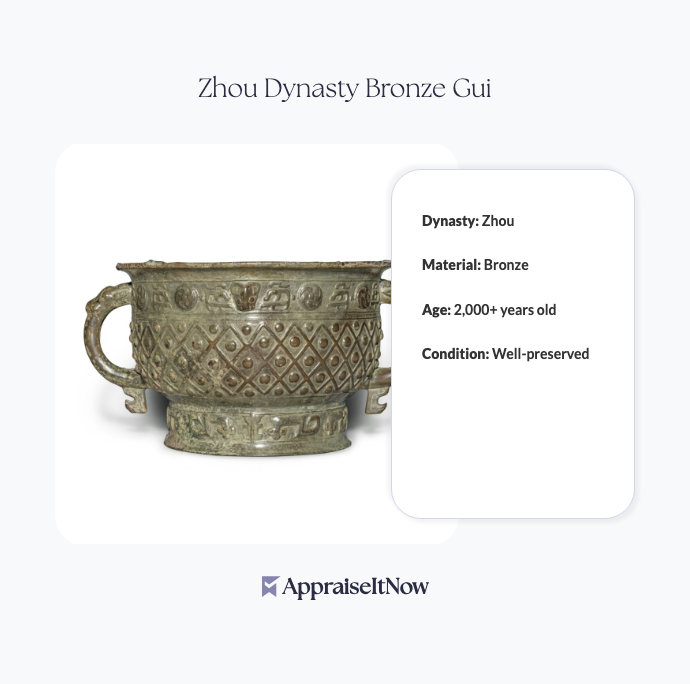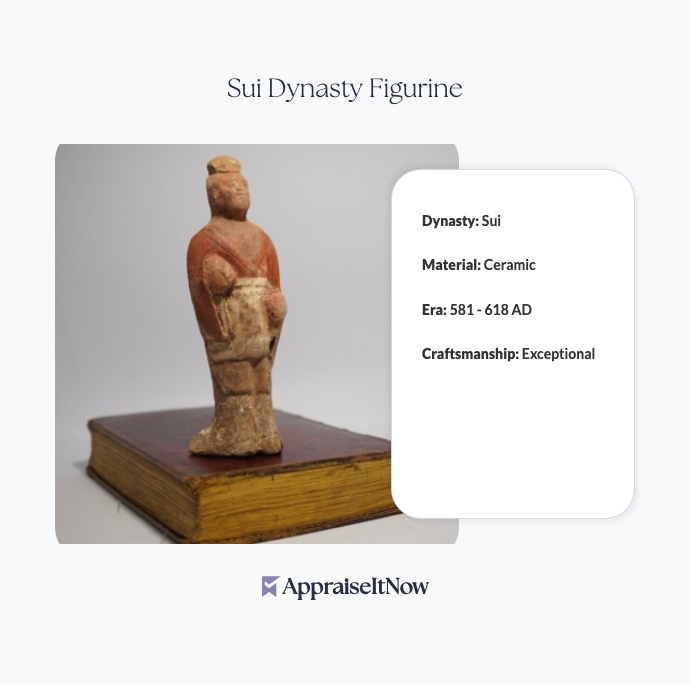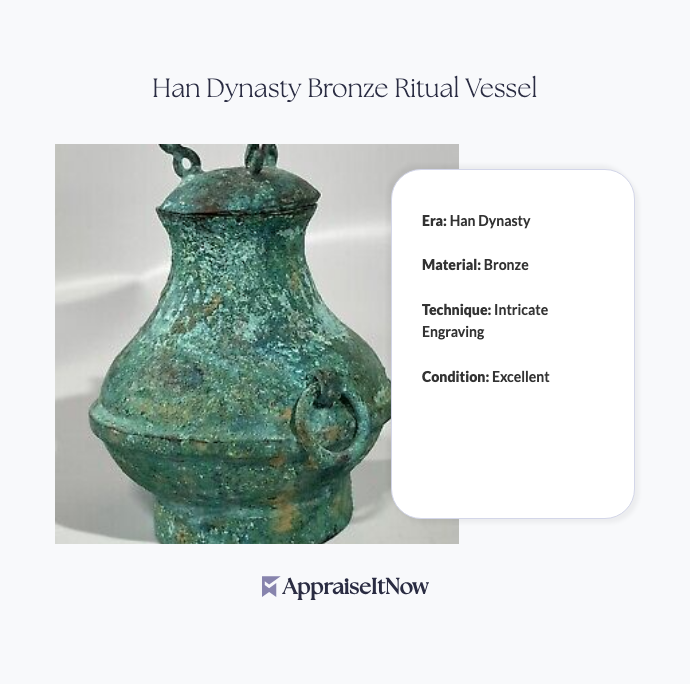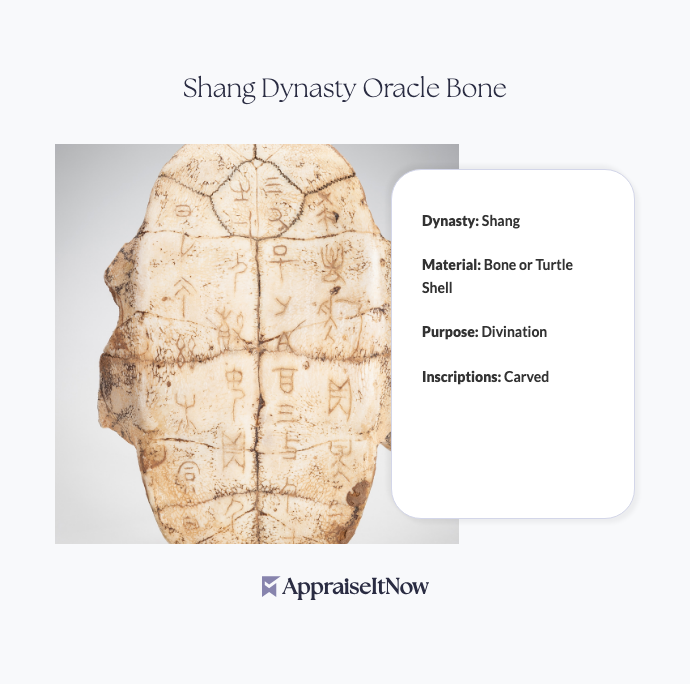<h1>How to Get Your Zhou Dynasty Bronze Gui Appraised</h1>
<p>The Zhou Dynasty Bronze Gui represents one of ancient China's most prized ceremonial vessels, commanding valuations between <strong>$22,000 and $34,000</strong> in today's collector and museum markets. Whether you've inherited a Gui, discovered one in an estate, or are considering acquisition, understanding how to properly appraise this significant artifact ensures you get accurate documentation and maximize your investment's potential.</p>
<h2>Understanding What Makes a Zhou Dynasty Bronze Gui Valuable</h2>
<p>A bronze gui is a ceremonial food or wine vessel used exclusively in royal and religious rituals during ancient China's Zhou Dynasty (1046-256 BC). Unlike decorative objects, the Gui served functional purposes in elaborate court ceremonies, which fundamentally shapes its historical and monetary worth. Your Gui's value stems not merely from its age—bronzes have been produced for over 3,000 years—but rather from its specific historical context, manufacturing excellence, and preservation condition.</p>
<p>The Zhou Dynasty produced some of China's finest bronze work, and the Gui exemplifies this mastery. Cast using exceptional bronze casting techniques perfected over centuries, authentic Zhou Dynasty examples feature intricately decorated surfaces with auspicious motifs that tell stories about ancient Chinese beliefs and social hierarchies. These aren't merely decorative flourishes; they represent documented cultural practices that scholars and collectors actively seek for museums and serious private collections worldwide.</p>
<div class="callout tip"><p><strong>Appraisal Insight</strong></p>
<p>Zhou Dynasty bronzes are considered national treasures in China, and export regulations significantly impact valuation and ownership legality depending on your location.</p></div>
<h2>Key Factors That Determine Your Gui's Appraisal Value</h2>
<p>When professional appraisers evaluate your bronze gui, they examine multiple interconnected factors that collectively establish market value. The first consideration involves dating authenticity—pieces first produced in the 11th century BC command substantially different valuations than later Zhou productions. Rarity plays a decisive role; one of the rarest Zhou Dynasty artifacts, an authentic Gui in strong condition represents a remarkable find that appraisers approach with particular scrutiny.</p>
<p>Your Gui's physical condition directly influences its $22,000-$34,000 valuation range. Well-preserved examples with minimal corrosion, intact decorative elements, and original patina typically position toward the higher end, while pieces requiring conservation work or showing significant wear may appraise lower. This mirrors considerations when appraising <a href="/types/antique-artwork">antique artwork</a>, where preservation status and restoration history profoundly affect professional valuation.</p>
<p>The decorative motifs adorning your vessel provide essential authentication markers. Genuine Zhou Dynasty Guis feature specific patterns reflecting period-appropriate artistic conventions—stylized animals, geometric designs, and symbolic inscriptions that skilled conservators can verify through detailed examination. Understanding how to identify ancient bronze requires specialized expertise, which certified appraisers bring through formal training and comparative analysis.</p>
<h2>Provenance Documentation and Legal Compliance</h2>
<p>Before seeking appraisal, understand that Zhou Dynasty bronze pieces occupy a complex legal landscape regarding ownership and export. Many nations, particularly China, maintain strict cultural patrimony laws governing bronze artifacts. Your Gui's provenance—its documented ownership history—becomes critically important for establishing legal possession and facilitating future sales or insurance claims.</p>
<p>When was the Zhou Dynasty in history? The Zhou Dynasty spanned roughly 800 years (1046-256 BC), making it one of China's longest and most culturally productive periods. This extended timeline means various production methods, decorative styles, and metal compositions evolved throughout the era. Professional appraisers specializing in Asian artifacts understand these chronological distinctions and can help date your piece more precisely, which directly affects valuation.</p>
<p>Gather whatever documentation accompanies your Gui—acquisition records, previous appraisals, exhibition catalogs, or scholarly references. This paper trail becomes invaluable during professional appraisal, as it establishes legitimacy and potentially increases value. Even fragmentary records help appraisers contextualize your piece within the broader Zhou bronze market. For comprehensive guidance on this aspect, explore our resource on <a href="/blog/exploring-the-role-of-provenance-in-art-appraisals-assessing-historical-significance">exploring the role of provenance in art appraisals</a>.</p>
<div class="callout note"><p><strong>Legal Consideration</strong></p>
<p>Verify ownership legality before pursuing appraisal, particularly if your Gui originated from international sources or estate acquisitions predating current cultural patrimony laws.</p></div>
<h2>Authentication and Technical Examination</h2>
<p>How to authenticate Chinese bronze? Professional appraisers employ multiple verification methods that go far beyond visual inspection. The process mirrors <a href="/blog/appraising-artifacts-and-antiquities-evaluating-historical-finds">appraising artifacts and antiquities</a>, requiring specialized knowledge of material composition, casting techniques, and period-appropriate decorative conventions.</p>
<p>Authentic Zhou Dynasty bronzes display specific metallurgical signatures that testing can verify. Appraisers examine the bronze composition—genuine Zhou pieces contain copper, tin, and lead in proportions consistent with period production methods. X-ray fluorescence (XRF) analysis, a non-destructive testing method, can determine elemental composition without damaging your artifact. Patina analysis—the colored oxidation layer covering the bronze—provides chronological clues; genuine antique bronzes develop distinctive patinas that modern forgeries struggle to replicate convincingly.</p>
<p>The casting method leaves telltale evidence that trained appraisers recognize. Zhou Dynasty artisans used section-mold casting techniques, creating specific join lines and casting marks that differ from later production methods. Decorative elements show period-appropriate wear patterns; genuine antique pieces display predictable damage consistent with centuries of use and handling, while modern reproductions often exhibit artificial aging or suspiciously uniform wear distribution.</p>
<h2>Selecting a Qualified Appraiser for Asian Antiquities</h2>
<p>Finding the right professional appraiser substantially impacts both your Gui's valuation accuracy and the documentation's credibility for insurance, legal, or sale purposes. You want an appraiser holding credentials from recognized professional organizations—the <strong>American Society of Appraisers (ASA)</strong>, <strong>International Society of Appraisers (ISA)</strong>, or similar bodies that maintain rigorous standards and continuing education requirements.</p>
<p>Look specifically for appraisers with documented expertise in Asian art and antiquities, particularly those demonstrating knowledge of Chinese bronzes and ritual vessels. Ask potential appraisers about their experience appraising similar Zhou Dynasty pieces, museum affiliations, and whether they maintain professional liability insurance. Their willingness to explain methodology, provide detailed written reports, and stand behind valuations indicates professional credibility.</p>
<p>AppraiseItNow connects you with certified appraisers across the United States who specialize in <a href="/blog/appraising-asian-art-and-antiques-understanding-cultural-significance-and-value">Asian art and antiques</a>, ensuring your Zhou Dynasty Bronze Gui receives expert evaluation. Our network includes specialists in Chinese ceramics, bronzes, and ritual vessels—precisely the expertise required for accurate valuation of these complex artifacts.</p>
<h2>The Appraisal Methodology and Valuation Approaches</h2>
<p>Professional appraisers employ standardized approaches when determining your Gui's value within the $22,000-$34,000 range. The <strong>comparable sales approach</strong> examines recent auction results and private sales of similar Zhou Dynasty bronzes, establishing market precedent. This requires access to specialized databases tracking Asian art markets and understanding regional variations in collector demand.</p>
<p>The <strong>cost approach</strong> considers reproduction or restoration expenses, though for ancient artifacts this methodology carries less weight than comparable sales. What makes the Zhou Dynasty special? Its position as a culturally foundational era in Chinese history means Zhou bronzes command premiums based partly on historical significance that transcends pure material value.</p>
<p>Appraisers also evaluate <strong>condition-adjusted valuations</strong>, where professional conservation costs factor into overall worth assessment. When your Gui requires restoration work, appraisers must determine whether conservation would increase overall value or represent expenditure exceeding the appreciation potential. This parallels considerations explored in <a href="/blog/the-impact-of-restoration-and-conservation-on-art-appraisals-balancing-preservation-and-value">the impact of restoration and conservation on art appraisals</a>.</p>
<h2>Understanding the Six Dynasties and Zhou's Unique Position</h2>
<p>When considering bronze ritual vessels from Zhou Dynasty context, understanding China's broader dynastic timeline helps contextualize your artifact's significance. The Zhou Dynasty predated many later dynasties and established cultural patterns—including bronze production and ceremonial usage—that influenced centuries of subsequent Chinese civilization. Bronze ritual vessels Zhou Dynasty represent the apex of this tradition, with Guis standing among the most prestigious forms.</p>
<p>The question "What are the 6 dynasties of China?" often confuses collectors, as China experienced far more than six dynasties throughout its history. However, understanding key dynastic periods helps appraisers identify your piece's chronological placement. Zhou Dynasty bronzes occupied a unique position—they preceded the imperial standardization of later dynasties while establishing foundational artistic and technical standards that collectors recognize and value highly.</p>
<h2>Conservation and Long-Term Value Preservation</h2>
<p>After obtaining your Gui's professional appraisal, protecting its value requires appropriate preservation strategies. Bronze vessels deteriorate through oxidation, corrosion, and environmental exposure; maintaining stable temperature and humidity prevents further degradation. Unlike concerns about <a href="/blog/how-to-properly-store-and-maintain-your-memorabilia-and-collectibles">properly storing collectibles</a> that focus on general collections, Zhou Dynasty bronzes demand museum-quality preservation.</p>
<p>Avoid aggressive cleaning or restoration attempts without professional guidance. Modern conservation practices prioritize preservation over aesthetic restoration, meaning your Gui's original patina—even if darkened by centuries—typically preserves more value than aggressive cleaning would. When considering conservation, consult the appraiser or a museum conservator specializing in Asian bronzes before undertaking any work.</p>
<p>Climate-controlled storage between 50-70°F with 45-50% humidity prevents corrosion acceleration. Keep your appraisal documentation alongside the artifact, as provenance records become increasingly important as the piece ages within your collection. This mirrors best practices for <a href="/blog/evaluating-cultural-heritage-appraisals-of-indigenous-art-and-artifacts">evaluating cultural heritage</a>, where documentation preservation equals artifact preservation in importance.</p>
<div class="callout tip"><p><strong>Preservation Priority</strong></p>
<p>The patina on ancient Zhou Dynasty bronzes—considered undesirable in earlier centuries—now represents authenticity markers that increase rather than decrease value among serious collectors and museums.</p></div>
<h2>Insurance and Legal Documentation</h2>
<p>Your professional appraisal report becomes essential documentation for insurance purposes. Standard homeowners or collectors' policies typically limit coverage for high-value antiquities; most insurers require certified appraisals before issuing agreed-value or replacement-cost coverage on pieces valued above $10,000. Your Zhou Dynasty Bronze Gui, positioned within the $22,000-$34,000 range, absolutely requires specialized insurance documentation.</p>
<p>Provide your appraiser detailed information about any legal restrictions affecting your Gui's ownership or sale. Export regulations, cultural patrimony laws, and ownership documentation requirements vary significantly by jurisdiction. A thorough appraisal report should address these legal considerations, providing you confidence that your ownership stands on solid ground and future disposition options remain available.</p>
<p>The appraisal also facilitates estate planning, should you wish to donate your Gui to a museum or include it in your will. Tax implications of such donations require documented valuations, making professional appraisal reports invaluable for both the donor and recipient institution. Beyond acquisition and ownership, appraisals support the broader mission of <a href="/blog/evaluating-the-cultural-significance-of-art-appraisals-beyond-monetary-value">evaluating the cultural significance of art appraisals</a>.</p>
<h2>When and Why You Should Update Your Appraisal</h2>
<p>Market values fluctuate based on collecting trends, economic conditions, and discovery of comparative pieces. The Zhou Dynasty bronze market has appreciated steadily as collectors recognize the rarity and cultural significance of these artifacts. Updating your Gui's appraisal every 3-5 years maintains accurate insurance coverage and reflects changing market conditions.</p>
<p>Certain circumstances necessitate immediate reappraisal: after conservation work, if you discover additional documentation enhancing provenance, or when planning sale or donation. Professional appraisers familiar with contemporary Asian art markets can position your piece accurately within current collector demand, ensuring you benefit from market appreciation or understand market softness affecting valuation.</p>
<div class="callout note"><p><strong>Key Takeaway</strong></p>
<p>A certified professional appraisal of your Zhou Dynasty Bronze Gui provides the documentation, authentication, and market valuation essential for insurance protection, legal compliance, and confident ownership of this rare and culturally significant artifact. Whether you're preserving a family heirloom or considering sale, expert appraisal services ensure your Gui receives appropriate recognition and protection within today's specialized Asian antiquities market.</p></div>







.avif)







